Our Lady of Charity
Our Lady of Charity, also known as Our Lady of El Cobre, Nuestra Senora de la Caridad del Cobre or "la Virgen de la Caridad", is a popular Marian title of the Blessed Virgin Mary known in many Catholic countries.
Our Lady of Charity of El Cobre Queen and Patroness of Cuban peoples | |
|---|---|
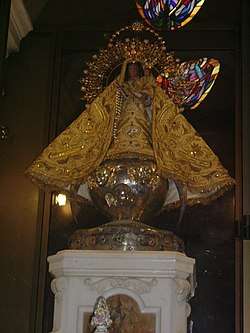 The present image enshrined in the Minor Basilica of Nuestra Senora Caridad del Cobre | |
| Our Lady of Charity, Mother and Patroness of Cuba, La Cachita | |
| Venerated in | Roman Catholic Church |
| Major shrine | Basilica of El Cobre, Cuba |
| Feast | September 8, Feast of Nativity of the Blessed Virgin Mary |
| Attributes | The Blessed Virgin Mary carrying the Christ child and holding a crucifix atop an inverted crescent moon, with triple cherubs, encrusted with jewels and golden crown and aureole halo, embroidered gold mantle with the Cuban flag |
| Patronage | Cuba, Cuban peoples, salt and copper miners |
| Controversy | Cuban and slave independence, tolerance towards mixed Mulatto races |
Several known Marian images with the same title exist around the world while a particular Hispanic image is pontifically designated by Pope Benedict XV as the Patroness of Cuba. The present image, of the Madonna and Child, is enshrined in the National Shrine Basilica of Our Lady of Charity of El Cobre, built in 1926 and situated in the village El Cobre, near Santiago de Cuba. Pope Pius XI granted a Canonical Coronation for the image on 20 December 1936. The feast day of Our Lady of Charity is September 8; the solemn Nativity of the Blessed Virgin Mary.[1]
Various similar Marian images predating the Cuban image have a similar title as well as having been granted a canonical coronation by the Popes and can be found in the Spanish cities of Cartagena, Villarrobledo, Illescas, Loja, La Garrovilla, and Toledo, Spain along with its replicated copies in Basilica Minore of Our Lady of Charity in Agoo, and the image of Bantay Church in Ilocos Sur, Philippines.
History

The history of the La Virgen de la Caridad del Cobre, began around 1612. The image is thought to have been brought by Spaniard colonists from the town of Illescas, a province in Toledo, Spain where a similar statue of the Virgin Mary of Charity was already well-venerated.
Local legend recalls the Spanish captains who bring with them religious Marian images to guide and protect them from English pirates at sea. Two Native American or Indian brothers, Rodrigo and Juan de Hoyos, and an African slave child, Juan Moreno, set out to the Bay of Nipe for salt.[2] They are traditionally given the moniker the "three Juans". They needed the salt for the preservation of the meat at the Barajagua slaughter house, which supplied the workers and inhabitants of Santiago del Prado, now known as El Cobre. While out in the bay, a storm arose, rocking their tiny boat violently with incoming waves. Juan, the child, was wearing a medal with the image of the Virgin Mary. The three men began to pray for her protection. Suddenly, the skies cleared, and the storm was gone. In the distance, they saw a strange object floating in the water. They rowed towards it as the waves carried it to them. At first they mistook it for a bird, but quickly saw that it was what seemed to be a statue of a girl. At last they were able to determine that it was a statue of the Virgin Mary holding the child Jesus on her left arm and a gold cross in her right hand. The statue was fastened to a board with an inscription saying "Yo Soy la Virgen de la Caridad" or "I am the Virgin of Charity." Much to their surprise, the statue remained completely dry while afloat in the water.
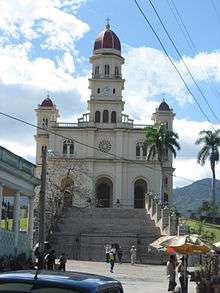
Overjoyed by what they had discovered, they hurried back to Barajagua. They showed the statue to a government official, Don Francisco Sánchez de Moya, who then ordered a small chapel to be built in her honor. One night, Rodrigo went to visit the statue, but discovered that the image was gone. He organized a search party, but had no success in finding Our Lady of Charity. Then, the next morning, she was back on the altar, as if nothing had happened. This was inconceivable as the chapel had been locked. This event happened three times. The people of Barajagua came to the conclusion that she wanted to be in a different spot, so they took her to El Cobre. She was received with much joy in El Cobre, and the church there had its bells ring on her arrival. It was at this point that she became known as "Nuestra Señora de la Caridad del Cobre" or "Our Lady of Charity of El Cobre". Much to the dismay of people in El Cobre, the disappearance of the statue continued to happen.[3]
One day, a young girl named Jabba was playing outside, pursuing butterflies and picking flowers. She went towards the mountains of the Sierra Maestra, where she came across the statue on top of a small hill. There were those who did and those who did not believe the little girl's testimony, but in the end, the Virgin was taken to the spot of her discovery, where a church was erected for her.[3]
Before the famous image on 19 May 1801, a royal edict from king Charles IV of Spain decreed that Cuban slaves were to be freed from the El Cobre copper mines. The story circulated around the island quickly. Many felt that the Virgin purposely chose to have her sanctuary in El Cobre because it is located in Oriente Province. Later folk legends associated the taking of copper materials to their homes after having it blessed near the Virgin's sanctified image as a form of souvenir and miraculous healing.
Description
The Cuban statue venerated measures about 16 inches tall; the head is made of baked clay covered with a polished coat of fine white powder. Her feet rest on a brilliant moon, while angels spread their golden wings on a silver cloud. The child Jesus raises his right hand as in a blessing, and in his left hand he holds a golden globe. A popular image of Our Lady of Charity includes a banner above her head with the Latin phrase “Mater Caritatis Fluctibus Maris Ambulavit” (Mother of Charity who walked on the road of stormy seas).[4] Originally, the robes on the image were white in color. Newer robes are embroidered with gold and silver, which includes the national shield of Cuba. Among Cuban religious devotees, the image is given the familiar title of La Cachita.
Pontifical approbations

Cuban revolutionary leader Carlos Manuel de Céspedes presented the Cuban banner to the image along with his soldiers who wore a similar medal while Cuban general Calixto Garcia bowed at the image during a Holy Mass in honor of Mambises resistance. Our Lady of Charity acquired the title La Virgen Mambisa or the Virgin for Cuban Independence.[5]
On 24 September 1915 the Cuban revolutionaries wrote a letter petitioning the Pope Benedict XV to honor her as Patroness of their country.
- Pope Benedict XV declared Our Lady of Charity of El Cobre Patroness of Cuba on 10 May 1916 at the written request of the soldier veterans of the Cuban War of Independence.[4][6]
- Pope Pius XI granted a Canonical Coronation for the image during the Eucharistic Congress at Santiago de Cuba on 20 December 1936 by Monsignor Valentin Zubizarreta y Unamunsaga.
- Pope Paul VI, in his Papal bull Quanto Christifideles then raised her sanctuary to the category of Minor Basilica on 22 December 1977 through the appointed Papal legate Cardinal Bernardin Gantin.[7]
- Pope John Paul II solemnly crowned her again during his apostolic visit on 24 January 1998.
- Pope Benedict XVI awarded a Golden Rose in honor of the image and her shrine on 27 March 2012.
- Pope Francis enshrined a brass statue given to Pope Benedict XVI by Cuban bishops (in May 2008) within the Gardens of Vatican City in August 2014, then enshrined in 2016 at the 13th slot.[8]
Veneration
The statue stands on a pedestal behind glass above the altar in the El Cobre basilica. The statue represents the Blessed Virgin Mary in her capacity of the Mother of God. Devotees believe that in reverencing the image they thus pay respect to the person it signifies. The color yellow is associated with the Virgin of Charity, and her shrines are often filled with yellow flowers.[5]
A chapel of Our Lady of Charity exists within the Basilica of the National Shrine of the Immaculate Conception in Washington, D.C.[4][9]
Significance
The Virgin is one of the island’s most treasured figures, representing hope and salvation in the face of misfortune.[10] Over time, La Cachita "has become a quintessential symbol of Cuban identity".[5] She unites both those at home and abroad, across lines of race and class. Wherever Cuban immigrants settled, they brought with them their devotion to la Caridad.[11] Emilio Cueto points out the Christian themes suggested by La Cachita: "She came to Cuba bearing the greatest of gifts—her own child—and appeared not to a priest or bishop, but to common men. She spoke not just to the aboriginal people, but also to the Spaniards, Creoles, and African slaves."[12] For Cubans who follow Yoruban religious practices, La Virgen de la Caridad is syncretized with the orisha Ochún.
On his visit to Cuba in 2015, Pope Francis said,
"She has accompanied the history of the Cuban people, sustaining the hope which preserves people’s dignity in the most difficult situations and championing the promotion of all that gives dignity to the human person. The growing devotion to the Virgin is a visible testimony of her presence in the soul of the Cuban people …. I will have occasion to go to El Cobre, as a son and pilgrim."[5]
In 1954, American author Ernest Hemingway donated his Nobel Prize in Literature medal for The Old Man and the Sea to the people of Cuba at the shrine of Caridad del Cobre in Cuba.[13] The medal was stolen in 1986, but was recovered days later upon the threat of Raul Castro that it be returned or the thieves suffer the consequences.[14][15] After its return, it was, for some time, hidden from view. The medal is very rarely present in the image and only worn during solemn and Papal occasions.
Our Lady of Charity venerated in other countries
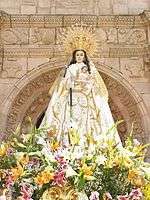
Spain
An earlier image of Our Lady of Charity predating and sourcing the Cuban image is venerated in the town of Illescas, Toledo, Spain. Legend recalls that it was copied from a "Saint Luke" image from Antioch and brought by Saint Paul the Apostle to Toledo between the year 50 and 60 A.D. From that date, the image remained when the Archbishop of Toledo Eugenius II of Toledo, who placed the image in a Benedictine monastery. In the 16th century, the image was transferred to a local Hospital of Charity where a famed miraculous healing of paralyzed patient Francesca de la Cruz took place in 1562. During the same time, the image was revised, separating the heads and hands of the Virgin from its fully formed or detallado style, in order to allow vestments and jewels to fit the image.
The image was granted a Canonical coronation on 12 October 1955 at the orders of Pope Pius XII through the Papal legate, Cardinal Enrique Pla y Deniel.[16] Many copies of this image was sent out into the territories in the Kingdom of Spain, one being the famous Cuban version. The image celebrated its 50th anniversary of papal recognition with a Pontifical High Mass in October 2005.
France
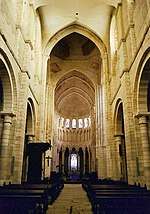
La Charité-sur-Loire was the home of the Abbaye de la Charité, a very large and famous Cistercian monastery. When the priory church, Notre-Dame-de-La-Charité, was built in the 11th century, it was the second largest building in Europe, only surpassed by the church at Cluny Abbey. The nave was shortened after the fire of 1559 destroyed its roof. The church has been on the list of UNESCO World Heritage Sites since 1998. It currently serves as a parish church dedicated to Notre Dame de la Nativité.
John Eudes founded the Order of Our Lady of Charity of the Refuge to give reformed prostitutes a place to go. The order survives today with many other charitable activities. Offshoot orders include both apostolic and contemplative Sisters of Our Lady of Charity of the Good Shepherd, which have now been joined back together as one order.
There was a pilgrimage chapel of Our Lady of Charity near St.-Laurent-sur-La-Plaine which was destroyed by order of the French revolutionary government in 1791. Shortly afterward, the Virgin Mary was reported to be seen on the ruined altar and in a nearby oak tree.[17] This set off more pilgrimages and became part of the unrest leading up to the War in the Vendee.
Philippines
In the Philippines, Our Lady of Charity is known by its Spanish predecessor, the original Our Lady of Lacara (circa 1494), later known as Apo Caridad in Ilocano language. The Marian title is not associated with the Cuban image, but rather the older Marian image venerated in Toledo, Spain.
- The image of Our Lady of Charity, Apo Caridad de Bantay is enshrined at the Bantay Church in Bantay, Ilocos Sur in Northern Luzon and was officially crowned by Pope Pius XII on 12 January 1956.
- The image of Our Lady of Charity is also within the Minor Basilica of Our Lady of Charity in Agoo, La Union is the Apo Caridad ng Agoo. The image was granted a canonical coronation on 1 May 1971 under the Papal nuncio Carmine Rocco at the mandate of Pope Paul VI.
United States
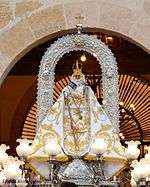
On 8 September 1961, the Archdiocese of Miami celebrated the feast of Our Lady of Charity with 30,000 Cuban exiles at Miami Stadium where a 16-inch replica of the statue of Our Lady of Charity was smuggled out of Cuba. Due to the overwhelming Cuban devotion to this Marian title in 1966, the Archdiocese of Miami announced the construction of the Shrine of Our Lady of Charity. Construction was begun on the shrine, known as La Ermita de la Caridad, the following year on the shores of Biscayne Bay in the Coconut Grove section of Miami. The shrine was completed in 1973, built with donations by new Cuban exiles.[18]
Churches
United States
- La Ermita de la Caridad, Miami, Florida
- Our Lady of Charity, Cicero, Illinois
- Our Lady of Charity, Buffalo, New York
Philippines
- Our Lady of Charity Parish Church in Quezon City, Metro Manila
- Minor Basilica of Our Lady of Charity - Agoo, La Union
- National Shrine of the Our Lady of Charity - Bantay, Ilocos Sur
References
- Our Lady of Charity: Nuestra Señora del la Caridad del Cobre
- Rozett, Ella. "Historian". Nuestra Señora de la Caridad del Cobre (Our Lady of Charity of Cobre). Interfaith Mary Page. Retrieved 8 September 2013.
- "Story of Our Lady of Charity", Sanctuario Nacional Ermita de La Caridad
- "Our Lady of Charity", Knights of Columbus, September 1, 2007
- Montgomery, David. "Why the iconic Virgin of Charity means so much to Cubans and Pope Francis", The Washington Post, September 22, 2015
- Our Lady of the Exile : Diasporic Religion at a Cuban Catholic Shrine pp. 22-24 - Thomas A. Tweed Associate Professor of Religious Studies University of North Carolina
- Paulus Sextus, Papam. "Quanto Christifideles", A.A.S., vol. LXX (1978), n. 1, p. 11
- "Image of the Patron Saint of Cuba at Vatican Gardens", Radio Cadena Agramonte
- "Our Lady of Charity", Basilica of the National Shrine of the Immaculate Conception
- "Cuba Celebrates Our Lady Of Charity, Island's Patron Saint", NBC News, September 8, 2014
- Scaperlanda, María Ruiz (September 2011). "Island Queen: A reflection on Our Lady of Charity", U.S. Catholic (Vol. 76, No. 9, pages 55-56)
- Cuerto, Emilio. "The Surprising History of Cuba’s Patron Saint", Smithsonian, October 27, 2016
- Stephen K. Ryan, Ernest Hemingway keeps a promise with the Virgin Mary, MysticPost.com
- "Canadian-Cuban Friendship Association Toronto". Retrieved 29 September 2014.
- "El Cobre - Cuba". Retrieved 29 September 2014.
- Emilio Martin Aguirre. "EL SAYON". Retrieved 29 September 2014.
- France and the Cult of the Sacred Heart by Raymond Jonas
- Alvarez, Lizette (Sep 9, 2012). "400 Years Later, Still Revered in Cuba (and Miami)". New York Times. p. A15. Retrieved 2012-09-10.
External links
| Wikimedia Commons has media related to Our Lady of Charity. |